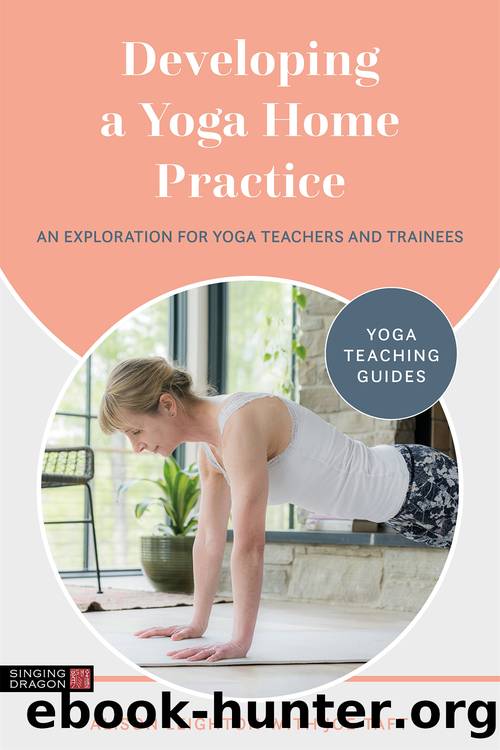Developing a Yoga Home Practice by Leighton Alison;

Author:Leighton, Alison;
Language: eng
Format: epub
Publisher: Jessica Kingsley Publishers
Published: 2021-10-21T00:00:00+00:00
Sensation in the pose
Ask yourself where, in the body, you have the most sensation in the pose. What is that sensation and does it differ from one side to the other? Be incredibly curious. Regard the sensation as a gift of treasure and surrender to it. If you fully participate in the sensation, you are attuned to information from your body.
Take Trikonasana as an example, a pose that may represent harmony to you. Ask yourself whether the shape feels harmonious in your body and then try this: as you move into Trikonasana, press into the mound of your front big toe. Do you feel pressure on the front knee, stuck in the hip of the back leg or too much gravity drawing your torso to the floor? Be aware of the sensations you are experiencing in the pose. Make adjustments if you need to. Now, do you feel all four corners of your feet, do your legs feel strong and is your back elongated and bright with an illumination from your heart as it twists towards the sky? Digest what you feel and explore whether anything further needs to change.
Notice when and where there is movement of your breath and redirect the breath if you need to. For example, in a closed pose such as Balasana, you may want to direct the breath more into the back body. Also notice if you stop breathing for a moment and whether that can actually be helpful. For example, explore what happens as you transition into a balancing pose such as Vrksasana. Does the breath remain smooth and regular or do you instinctively hold your breath as a way to find balance in the pose? Or perhaps you need to free the breath in some poses. For example, in Setu Bandha Sarvangasana, you might need to move the chin a fraction away from the top of your chest to create a freer flow of breath.
Does your body call for a counter-movement because your body knows, or does it simply want to rest in stillness for a few breaths? Listen for the feedback.
Your attitude in a pose is also sensation. For example, when I practice Ardha Dhanurasana, I can get frustrated with the effort it takes. If I then tune in to sensations in my physical body, I can feel that a narrow line of muscles in my back are strongly activated but probably need to be stronger. Thatâs where the frustration is coming from. My body knows.
Download
This site does not store any files on its server. We only index and link to content provided by other sites. Please contact the content providers to delete copyright contents if any and email us, we'll remove relevant links or contents immediately.
Bodyweight Strength Training by Jay Cardiello(7180)
Tools of Titans by Timothy Ferriss(6938)
Born to Run: by Christopher McDougall(6252)
Inner Engineering: A Yogi's Guide to Joy by Sadhguru(5888)
Asking the Right Questions: A Guide to Critical Thinking by M. Neil Browne & Stuart M. Keeley(4567)
The Fat Loss Plan by Joe Wicks(4234)
Bodyweight Strength Training Anatomy by Bret Contreras(4055)
Yoga Anatomy by Kaminoff Leslie(3697)
Science and Development of Muscle Hypertrophy by Brad Schoenfeld(3574)
Dynamic Alignment Through Imagery by Eric Franklin(3483)
The Four-Pack Revolution by Chael Sonnen & Ryan Parsons(3481)
ACSM's Complete Guide to Fitness & Health by ACSM(3462)
Yoga Anatomy by Leslie Kaminoff & Amy Matthews(3392)
Bodyweight Strength Training: 12 Weeks to Build Muscle and Burn Fat by Jay Cardiello(3348)
The Ultimate Bodybuilding Cookbook by Kendall Lou Schmidt(3311)
Exercise Technique Manual for Resistance Training by National Strength & Conditioning Association(3289)
Nutrition for Sport, Exercise, and Health by Spano Marie & Kruskall Laura & Thomas D. Travis(3233)
Nutrition for Sport, Exercise, and Health by Marie Spano & Laura Kruskall & D. Travis Thomas(3229)
Yoga Therapy by Mark Stephens(3219)
